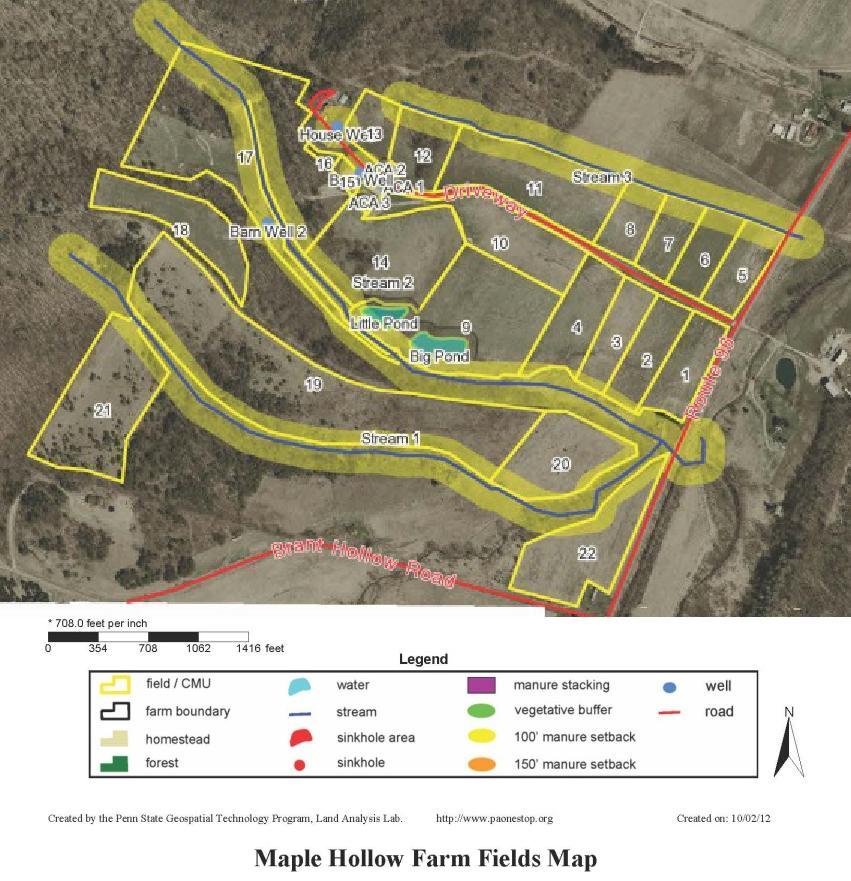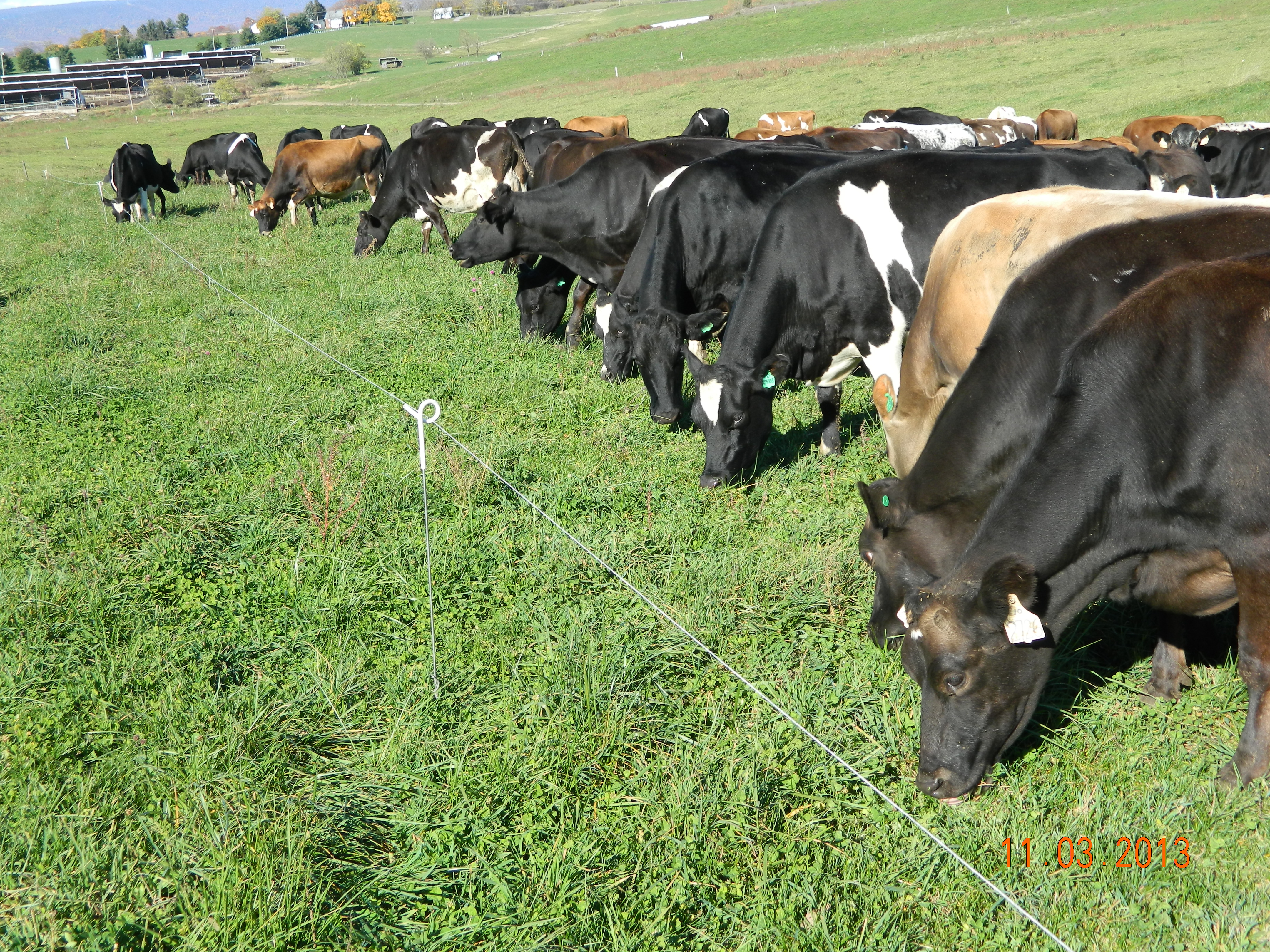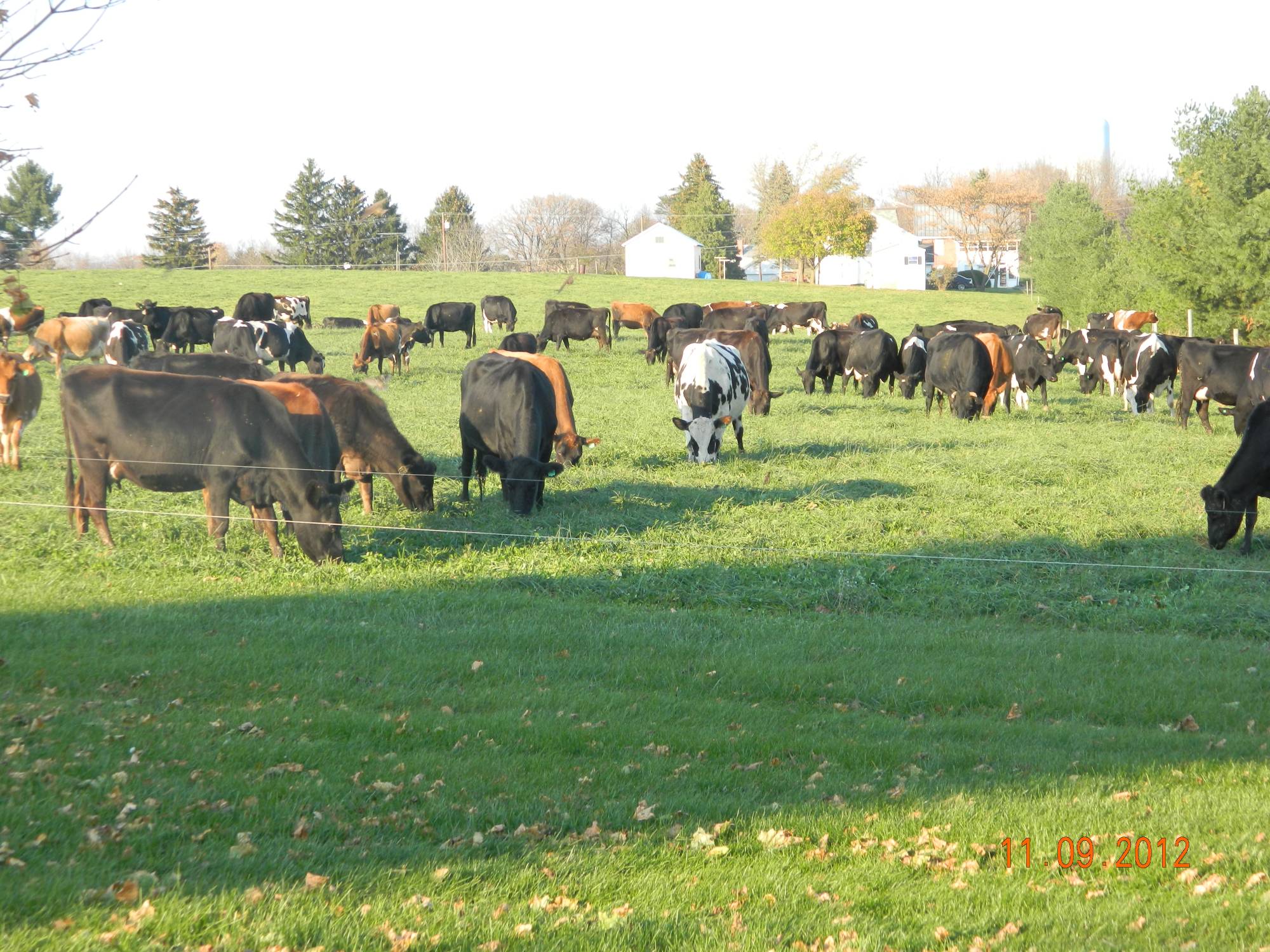The evening session was the Producer Showcase. This featured two pasture-based farm speakers.
Ms. Melanie Barkley, Maple Hollow Farm and Penn State Extension Educator, was the first presenter. She presented Matching Sheep Genetics to On-Farm Pasture Resources. Maple Hollow Farm has 3 livestock enterprises: Sheep - Aussie Dorsets, Tunis, Border Leicesters, Cattle - Feeder steers, and Chickens - pastured broilers, 100 raised twice yearly. However, the sheep enterprise is their main-stay. Her Husband, Brian, and she like Aussie Dorsets because of their performance on pasture: They thrive on grass - a 60-day old lamb can weigh 95-97 pounds, their reproductive performance - 200% lamb crop, and carcass quality - loin eye size of 2.1 to 3.1 inches. They learned about them on Future Farmer of America trips to South Wales, Australia.

They have 22 main pastures that they rotationally graze. The pasture soils range from flat and wet to steep, shallow, and shaley. Pasture forages are birdsfoot trefoil and Alice clover legumes and orchard-grass, perennial ryegrass, reed canarygrass on the flat and wet soils, and some bromegrass. They soil test regularly and lime fields to maintain a pH to grow legumes. They use high tensile wire fencing. Perimeter fencing is 5-6 strands. Subdivision fences are 2 strands of wire since they work off the farm during the day. Smaller subdivision fences are two strand polywire with tread-in posts.
Streambank fencing along all live streams and rock-armored, fenced stream crossings are their conservation practices. They utilize a variety of watering systems from concrete troughs to portable plastic troughs, gravity flow spring development water to well water, and even a solar powered water pump to pump water uphill - this waters the chickens, 100 drink a lot of water. Their pasture system consists of 4-5 days of grazing per section, clip following grazing, water provided in each pasture, residual grass height after grazing no shorter than 3 inches, 60-day rotation cycle, maintain soil pH, and use critters that work FOR you, not you for them.
Mr. Cliff Hawbaker, an organic pasture-based dairy farmer, was the last presenter of the evening session. He presented A Dairy Farm’s Transition to Organic. He owns two dairy farms, Hamilton Heights and Emerald Valley. Hamilton Heights is patterned after a West Coast dairy farm as supple-mental feed is brought in, not raised at the farm. He asked farmers that were going out of dairy to raise corn for him. He has 5 corn growers providing him grain corn.
He has been pasturing cows since 1999. In 2000, he went to Switzerland. This inspired him to convert his Hamilton Heights to all pas-ture by 2005. The Emerald Valley farm was converted to hay and pasture. 770 acres of hay and pasture with 670 acres of it fenced.

He then moved on to the organic certification process. He last used chemical fertilizer in 2009. The organic transition for him began in 2010. Anyone considering transitioning to organic milk production needs to find a market for the milk. He had a nearby independent organic milk processor that he chose out of two available choices. The person wanting to go organic must want to be a grass farmer, not a field crop producer. A transitioning organic dairy farmer should contact an organic certifying agency to get all the information required to understand the organic standards and time frames involved to get certified. It is a good idea to involve an already certified organic farmer willing to be a mentor so you can call to ask for advice when you are unsure about something.
For both crops and livestock, pick a date when you will use the last non-organic product. This is important if there is a lingering problem with a crop fertility issue or pest problem or livestock health issue. You may be better off using a non-organic treatment measure that quickly solves the problem before going to organic products only. Sometimes the organic choices are few and less effective. For cropland, there is a 3-year transition before they can be declared organic. Livestock is only a 12-month period of organic practices only.

Soil fertility is enhanced by plowing down high tonnage green manure crops and livestock manure. He uses brown midrib sorghum sudangrass as a green manure crop. He harvests the first crop and then discs in the second crop as a green manure crop. His pasture management involves rotational grazing, fall stockpiling, mob grazing, grazing tall, and summer fallow. He often hosts or attends Franklin County pasture walks to learn by sharing experiences. In southern PA 60% of the forage production occurs by the end of June. If grass production at that time of the year is lagging behind, begin culling cows by June 21st to avoid being short of pasture the rest of the grazing season and losing milk production. Once milk production falls to 5-10 lbs/day/cow, it is best to dry them off.
He likes to make “sweet hay”. Always seeking to make the best hay. Cannot afford to lose sugars in the grass by fermentation or respiration. He mows in the morning. He mows high; 48 hours later re-growth is 6-8 inches high. Four hours later, the morning mown hay is tedded. It takes 2 days to get the hay down to 20-25% moisture. He does not crimp the hay. He rakes the hay just ahead of the baler.
Mr. Hawbaker discussed some livestock health and reproductive issues for an organic dairyman. For mastitis there is a topical treatment that is acceptable. If the cow has a chronic health issue, sell her. Artificial insemination is acceptable but if non-organic bull semen is used, the off-spring cannot be sold as an organic animal. He likes cows that weigh about 1100 pounds that have a deep chest and barrel as they have more rumen volume for eating grass. He uses cross breeding for hybrid vigor.
Financial risk in transitioning to organic was the next issue brought up. Financial cash flow can be a challenge because changing from a conventional farming practice to an organic style has different cash flow expenses. The income can lag behind. The need for credit changes as farm transitions from a production cash flow and inputs system to a soil and livestock health and wellness system. Without some thought and planning, this can cause a negative net worth until performance catches up to your goal and plan. Be sure to right size the farm, livestock demand for forage has to be consistently matched with forage production throughout the year. He enjoys grass farming as wildlife is more plentiful, meadowlarks in particular. He also likes to get a premium price for doing what he likes best, growing grass.
A question and answer period followed. Someone asked for more details about the pasture rotation system. He has 42 paddocks. The first rotation cycle ends May 1. Paddocks are halved between milkings. Springtime rotation cycle is 21 days; unused paddocks are hayed. Later on as grass growth slows down rotation cycle extends to 30 days, and during dry weather the rotation cycle is 42 days long. Some asked about feeding organic grain and its cost. Mr. Hawbaker responded that if you are going to feed organic grain, it would be better if you raised it yourself. Another person asked about clipping pastures after a grazing event. Mr. Hawbaker said he does not clip: he prunes (mows high). He likes to finish pruning pastures by 15-20 May. This concluded the evening session.